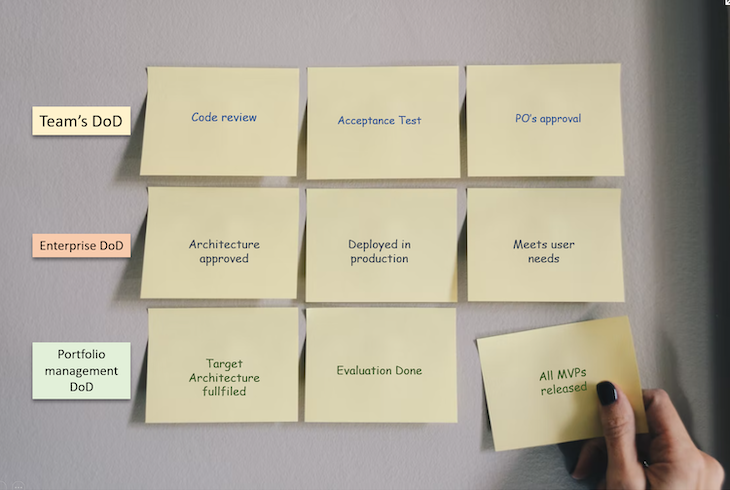In today’s fast-paced world, where innovations abound and technologies evolve daily, product development teams must constantly adapt to keep up. That means the organization must also embrace agile principles from top to bottom to nurture momentum.

An agile product development team comprises experts in various domains: software engineers, quality assurance experts, scrum masters, user experience designers, product owners, and more. Everyone contributes to product development in different stages with their expertise. Hence, there is a need to create a shared understanding of expectations around the development and deliver of the product.
In this guide, we’ll explain why creating a definition of done (DoD) is so important for scrum teams and product leaders to embrace agile ways of working. We’ll also define who creates the definition of done for user stories, features/epics, and themes/initiatives and distinguish the DoD from its cousin, the definition of ready (DoR).
The definition of done (DoD) is an agreed-upon checklist that clearly states when a user story, epic, or theme is considered accomplished.
According to The Scrum Guide:
“The Definition of Done creates transparency by providing everyone a shared understanding of what work was completed as part of the increment. If a Product Backlog item does not meet the Definition of Done, it cannot be released or even presented at the Sprint Review. Instead, it returns to the Product Backlog for future consideration.”
The primary purpose of the definition of done is to build consensus and allocate accountability to the appropriate stations so that the team can deliver quality products consistently. A clear definition of done is crucial not only for execution, but also for planning and estimation across all levels in the product organization.
Initially, the scrum framework established a definition of done for scrum teams during the development phase. Since then, it has been extended to all levels of the product organization.
For example, there are DoDs for themes, initiatives, and epics, which enable the organization to understand the product lifecycle, create relevant marketing plans, help with budget allocations, and evaluate the milestones and roadmap. In addition, an operating agreement benefits cross-functional team collaboration and the onboarding of any new team member.
When adopting agile ways of working, every process should add value to the organization. The definition of done follows and implements the core agile principles in product development.
Creating a clear understanding across the organization promotes transparency. It helps avoid unnecessary conflict and misunderstandings due to differences of opinion or perspective on the matter.
Continuous evaluation at each step following the DoD checklist enables thorough oversight before releasing a product to end users and acts as a security gate. It allows the team to focus on speed and delivery, encouraging self-driven innovation without hesitation.
Delivering features that can be implemented quickly with the appropriate levels of quality assurance and delivered to end users is another key agile principle. Quick learning and iteration also foster confidence within the product development teams to create innovation while maintaining quality assurance during delivery.
Let’s explore the definition of done at various levels — team, enterprise, and portfolio management — and go over some examples of what to include in the definition of done for.
We’ll also go over some examples of what to include in your definition of done checklist and who creates the definition of done at each level.

The widely known definition of done is for user stories at the scrum team level.
A user story is considered done when all the acceptance criteria are met and the product owner reviews and accepts the user story. Once accepted, the completed user story contributes to the team velocity.
The DoD checklists will vary from team to team, but here are some standard items to include in a DoD checklist for user stories:
The scrum team collaboratively defines and maintains the definition of done. The DoD checklist should reflect whether the scrum team has met every requirement and quality standard for all stories. It should also act as an official gatekeeping mechanism for stories to move from in-progress to done, ensuring quality and consistency along the way.
When working in cross-functional teams, the process of defining what qualifies as done should be collaborative. The DoD checklist is flexible and should be reviewed and adapted as required by the product team. The scrum master can act as a lead for managing and implementing the DoD checklist into the way of working.
The product manager can rely on the DoD for quality assurance before release if all the agreed-upon tasks are performed and checked by their respective accountable roles. The impact of the inventory can be incomplete user stories ending up in sprint backlog, which throws a wrench into planning for the next sprint and, ultimately, delays production.
At the feature or epic level, done means ready and shipped to the end user. An epic that is done has met all the criteria and fulfilled the user’s needs.
One or multiple user stories can conclude a feature in more than one sprint involving several cross-functional teams.
Here’s an example of DoD checklist for a feature/epic:
A shared understanding of the DoD on this level is essential if the quality of delivery to the end user is paramount. Furthermore, because multiple teams can be involved in the delivery and the development cycle may be longer, a well-defined and agreed-upon definition of done can help save time, increase efficiency, and ensure the quality and integrity of development before being released to production.
The DoD may affect your priorities and roadmap based on new discoveries and learnings. Items that do not fulfill the DoD can go back to the product backlog for the next increment.
The product manager can create a checklist on an epic level in collaboration with the architects, stakeholders, marketing team, design team, test lead, etc., and whoever is involved in tasks related to shipping the final product to users.
However, the product manager is accountable for ensuring that all the items in the DoD are executed. After all, the product manager’s foremost responsibility is to ship the product to the end users.
Having a DoD for a theme or initiative is a relatively new concept that emerged in response to the popularity of product lifecycle management.
The DoD at the theme level helps the organization to align during prioritization, clarifies if there is any need to shift the focus on a new initiative, and pulls the plug on any further development on an existing product. DoD aids with strategic focus and direction for the entire product organization.
The example of the checklist in DoD for themes/initiatives can include
The portfolio management team creates the definition of done for themes and initiatives. In addition, there is a growing need to evaluate the product at each stage to discern whether the product meets the defined market expectations.
The product manager is responsible for committing and fulfilling the checklist defined for their product, and management is required to carry out the necessary actions after the DoD is executed.
Inspecting the DoD checklist ensures correct organizational prioritization, focus, and budget allocation and minimizes the risk of unknown blind spots.
When you’re operating on a working agreement, there are often discussions about having two definitions clearly stated: a definition of done (DoD) and a definition of ready (DoR). However, in the scrum framework, only the DoD is officially defined; the DoR is optional.
Similar to the definition of done, the definition of ready is a checklist of things that should be ready before starting work on any new initiative. The objective of a definition of ready is to avoid confusion and blockers and increase efficiency when working on initiatives.
From my personal experience, a DoR is good to have but should not be a hardcore checkpoint that precludes you from starting anything new. If the product team focuses too much on the DoR, it may delay production and lead to missed missed opportunities.
The definition of done ensures consistency and quality deliverables, whereas the definition of ready aids with efficiency. In addition, the DoR aims to create a shared understanding and avoid confusion at the beginning of a new development project, whereas the DoD kicks in at the end of the delivery.
All frameworks designed to help various organizational structures adopt agile ways of working have at least one core tenet in common: learn and adapt to what works best for your product organization. The definition of done helps product leaders create a shared understanding and avoid any misinterpretation throughout the product lifecycle.
A DoD helps agile product teams ensure quality, fast-paced delivery, and consistency by taking a thorough inventory of criteria. The definition of done should also be reviewed and adapted according to your particular initiative. Product managers are accountable and responsible for the DoD’s execution at all levels.
The definition of done is not only practical during development; it is applicable at all levels of product management, from portfolio to the team level, providing transparency and clear direction for the entire product organization.
Featured image source: IconScout

LogRocket identifies friction points in the user experience so you can make informed decisions about product and design changes that must happen to hit your goals.
With LogRocket, you can understand the scope of the issues affecting your product and prioritize the changes that need to be made. LogRocket simplifies workflows by allowing Engineering, Product, UX, and Design teams to work from the same data as you, eliminating any confusion about what needs to be done.
Get your teams on the same page — try LogRocket today.

A practical guide for PMs who want to stop being bottlenecks, delegate smarter, and lead teams effectively with a clear ownership framework.

Stop letting unreliable data block features. Treat data as inventory to track quality, ownership, and ship with confidence.

Learn why slide decks slow teams down and explore better tools like whiteboards, PRDs, and prototypes to improve collaboration and alignment.

AI PM roles are evolving fast. Learn the five types of AI PMs, the skills they need, and how they shape AI products across industries.